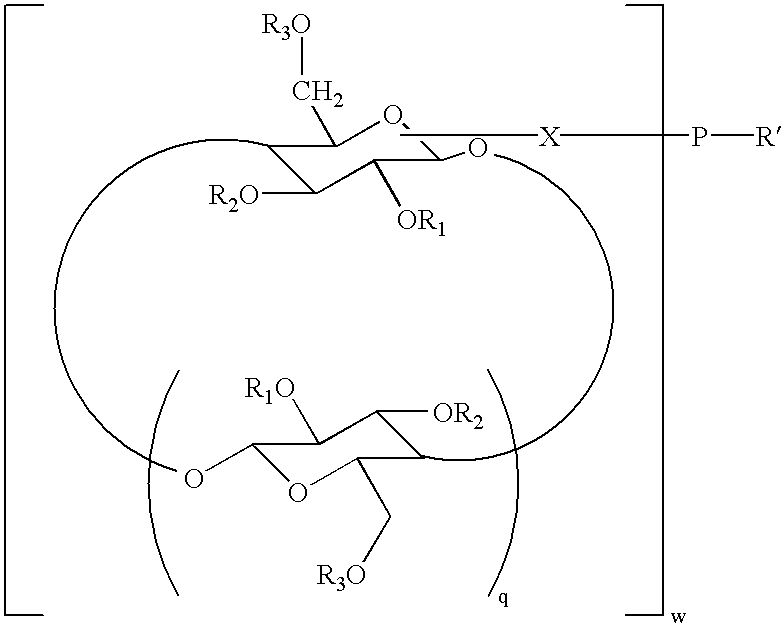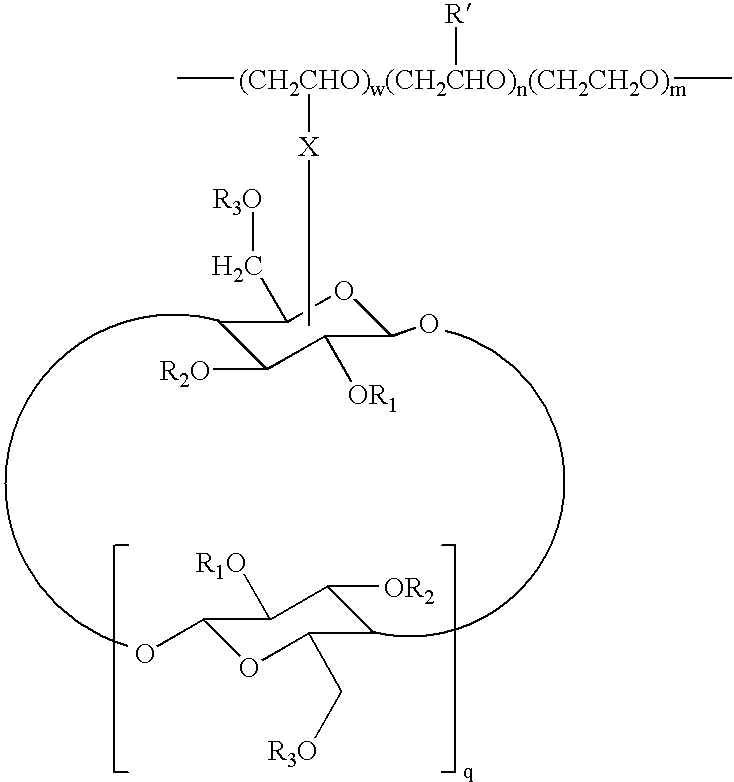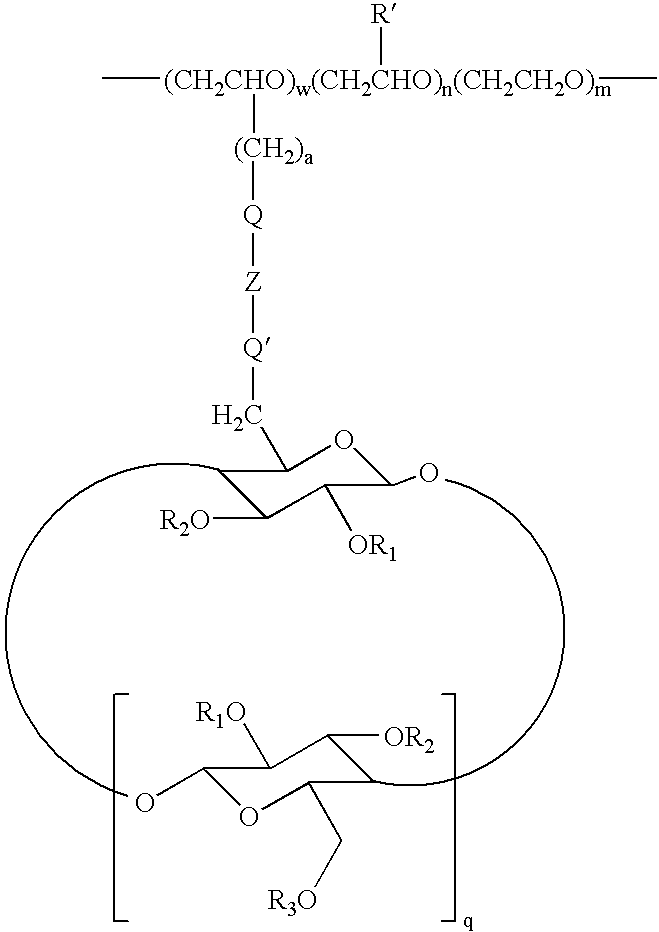Cyclodextrin grafted biocompatible amphilphilic polymer and methods of preparation and use thereof
a biocompatible, polymer technology, applied in the direction of powder delivery, macromolecular non-active ingredients, drug compositions, etc., can solve the problems of poor drug binding, increased cytotoxicity, and high degree of hydroxylpropyl substitution, so as to reduce the cytotoxicity of the drug/carrier complex and improve the solubility
- Summary
- Abstract
- Description
- Claims
- Application Information
AI Technical Summary
Benefits of technology
Problems solved by technology
Method used
Image
Examples
example 1
[0053]Materials and methods: PEG with pendant propionic acid groups (PEG-10PA and PEG-8PA, Mw=˜20 KD, SunBio, Inc., Anyang City, South Korea) was dried overnight in vacuo at room temperature. β-Cyclodextrin (TCI America, Portland, Oreg.) was dried in vacuo at 130° C. overnight before use. Other chemicals were from Aldrich Chemical Company, Inc. of Milwaukee, Wis.) and used as received without further purification. HPLC analysis was performed on a Waters system equipped with RI detector and Ultrahydrogel 120 and Ultrahydrogel 500 SEC columns. 1H-NMR was recorded on a Varian 400 MHz machine.
Synthesis of PEG-SS-CD (Compound 2)
Mono-6-(6-amino-3,4-dithio-hexylamino)-6-deoxy-β-cyclodextrin (Compound 1):
[0054]Cystamine dihydrochloride (1.0 g, 4.44 moles, Fw=225.2) was dissolved in 30 ml distilled water, followed by addition of 1.0 M KOH (8.88 moles) and mono-6-tosyl-β-cyclodextrin (0.5 g, Fw=1289) powder. The resulting suspension was stirred in a 70° C. oil bath overnight, then concentrate...
example 2
Synthesis of PEG-SS-AcCD (Compound 3)
[0056]PEG-SS-CD (compound 2, 1.0 g, ˜5 CDs / 20 kD-PEG) was dried in a P2O5 desiccator, followed by co-evaporation with 50 ml anhydrous pyridine. The residue was dissolved in 30 ml pyridine under protection of argon, followed by addition of 2.0 ml acetic anhydride (Fw=102.1, d=1.08). The mixture was dried on a rotary-evaporator after being stirred at room temperature for 2 days. The crude product was purified by repeated ether precipitation from methanol. HPLC (GPC) analysis showed a 0.46 minute time delay of the product compared to the starting polymer (Rt=19.70′ of the product vs. Rt=19.24′ of the reactant polymer). 1H-NMR analysis indicates that each 20 kD PEG contains about 5 CD moieties and all hydroxyl groups are acetylated. 1H-NMR (400 MHz, D2O): δ, 4.7-5.5(s, 14H, H1′, H3′), 3.4-5.5 (m, 382H, 35H-CD, 347H-PEG), 2.05 (m, 20H, H-Ac).
example 3
Synthesis of PEG-SS-DECD (Compound 7)
PEG-SS-NH2 (Compound 4):
[0057]Carboxyl group grafted PEG (PEG-8PA, 2.6 g, 2.0 mmole COOH group) was dissolved in 30 ml anhydrous DMF and cooled to 0° C. on ice. To this was added tributylamine (0.35 ml, 1.5 mmoles, Fw=185.36, d=0.778), followed by the addition of isobutyl chloroformate (0.20 ml, 1.5 mmoles, Fw=136.6, d=1.053). The mixture was stirred at 0° C. for 80 minutes and was carefully added to a solution cystamine (3.5 g, Fw=152.2, 23 mmoles) in 50 ml anhydrous DMF. The mixture was stirred at room temperature for 20 hours, concentrated to about 20 ml on rotary evaporator at 40° C., then dialysed against distilled water (4×5 L over 26 hours, Sigma D-0655, MWCO=12,000) after being diluted with 50 ml water. The dialysis solution was concentrated by rotary evaporation at 40° C., obtaining 4.1 g of syrup. The syrup was dissolved in 10 ml methanol, then precipitated by addition of 80 ml ethyl ether. The precipitate was collected by centrifugatio...
PUM
| Property | Measurement | Unit |
|---|---|---|
| molecular weight | aaaaa | aaaaa |
| molecular weight | aaaaa | aaaaa |
| molecular weight | aaaaa | aaaaa |
Abstract
Description
Claims
Application Information
 Login to View More
Login to View More - R&D
- Intellectual Property
- Life Sciences
- Materials
- Tech Scout
- Unparalleled Data Quality
- Higher Quality Content
- 60% Fewer Hallucinations
Browse by: Latest US Patents, China's latest patents, Technical Efficacy Thesaurus, Application Domain, Technology Topic, Popular Technical Reports.
© 2025 PatSnap. All rights reserved.Legal|Privacy policy|Modern Slavery Act Transparency Statement|Sitemap|About US| Contact US: help@patsnap.com



